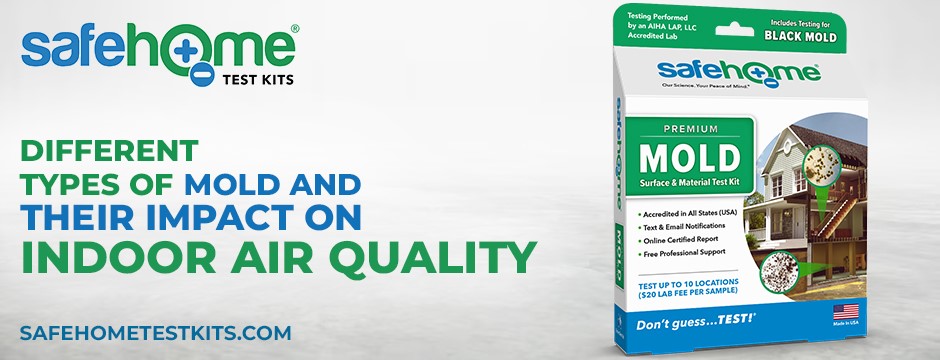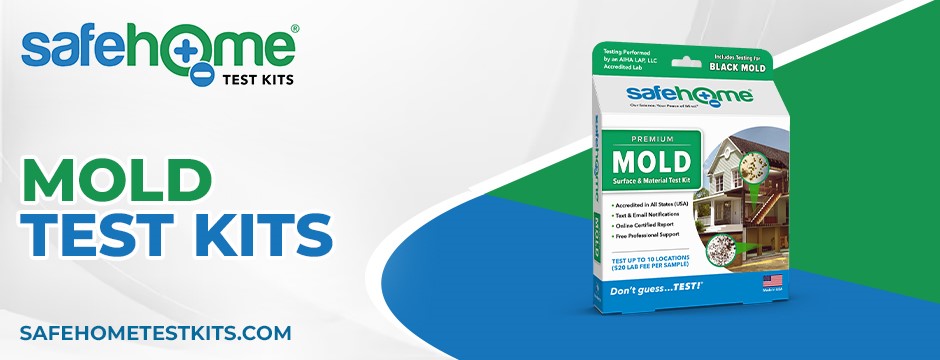Different Types of Mold and Their Impact on Indoor Air Quality

In an era where health and well-being take center stage, the quality of indoor air becomes a pivotal determinant of our daily lives. Amidst the quest for pristine air, the presence of mold within our living spaces often remains unnoticed. However, mold is not a mere aesthetic concern; it possesses the potential to profoundly affect indoor air quality and subsequently impact our health. This comprehensive guide endeavors to unveil the intricate realm of mold, exploring the diverse types of mold, their ramifications on indoor air quality, and proactive measures like utilizing mold test kits to ensure a safe and salubrious environment.
Understanding Different Types of Mold
Common Types of Mold
As we embark on the journey to comprehend the interplay between mold and indoor air quality, acquainting ourselves with the common types of mold that frequently infiltrate our living spaces becomes imperative. Among these are Aspergillus, Penicillium, and Stachybotrys. While Aspergillus plays a role in certain medication production, it can also trigger allergic reactions in susceptible individuals. Penicillium, renowned for its role in antibiotic production, can turn detrimental when it silently colonizes our walls. Then comes Stachybotrys, often dubbed “black mold,” notorious for generating mycotoxins with substantial health implications.
Uncommon Mold Species
Beyond these familiar names lies a spectrum of lesser-known mold species that can wield equally potent effects on indoor air quality. The adaptable and versatile Cladosporium finds habitat on diverse surfaces, be it the bathroom ceiling or window frames. Alternaria, characterized by its distinctive appearance, might be the culprit behind those seasonal allergies that unexpectedly arise. And let’s not forget Chaetomium, a less common yet impactful mold, frequently detected in water-damaged areas. Although these mold species receive less frequent attention, they possess the capacity to influence indoor air quality and our holistic well-being.
How Mold Affects Indoor Air Quality
Mold Growth and Spore Release:
The intriguing yet unsettling facet of mold lies in its growth and reproductive mechanisms. Mold flourishes in environments marked by excessive moisture, inadequate ventilation, and organic materials that serve as potential nourishment. Flourishing mold colonies release minuscule spores into the ambient air. These spores, so lightweight and microscopic that they remain suspended in the air we inhale, set forth on a journey laden with far-reaching consequences for indoor air quality.
Health Implications of Mold Exposure:
The implications of mold extend beyond the scope of aesthetics. Exposure to mold spores can wield detrimental health effects, particularly for individuals who are sensitive to allergens or who harbor preexisting respiratory conditions. Allergic reactions, encompassing sneezing, coughing, and itchy eyes, stand as common manifestations of mold exposure. Those grappling with asthma might encounter intensified symptoms, including wheezing and shortness of breath. Vulnerable segments of the population, namely individuals with compromised immune systems, children, and the elderly, face heightened susceptibility to the health impacts of mold exposure.
Identifying Mold in Your Environment
Visual Clues of Mold Presence:
The process of identifying mold growth often commences with vigilant observation. Visual cues, such as patches of discoloration on walls, ceilings, or other surfaces, might denote the presence of mold. Musty odors, akin to the scent of damp earth, can serve as indicators that mold is surreptitiously establishing its domain. Even if seemingly dried, water stains might furnish evidence of prior or concealed mold growth.
Professional Mold Inspection:
While visual cues are invaluable indicators, they might not consistently unveil the complete extent of mold presence. When grappling with suspicions of mold infestation, the expertise of professionals assumes paramount significance. Mold inspectors wield tools like mold test kits as well as the expertise to execute comprehensive assessments, frequently incorporating air and surface sampling. These examinations furnish insights into the mold types prevalent, the severity of the infestation, and the potential repercussions on indoor air quality.

Preventing and Managing Mold Growth
Moisture Control:
The cornerstone of preventing mold growth rests in mastering moisture control. Mold thrives in environments characterized by excess humidity, leaks, or suboptimal ventilation. By promptly addressing water leaks, deploying dehumidifiers in humid zones, and ensuring adequate ventilation, individuals can establish an environment that discourages mold colonization.
Proper Ventilation:
Effective ventilation emerges as an invaluable ally in the battle against mold. Well-ventilated spaces facilitate moisture dispersion, consequently diminishing the probability of mold proliferation. Environments prone to dampness, including bathrooms and kitchens, stand to benefit immensely from properly functioning ventilation systems. As an added precaution, keep track of mold growth by using a home test kit for mold!

Improving Indoor Air Quality
Cleaning and Maintenance:
A robust regimen of regular cleaning and maintenance stands as a pivotal factor in controlling mold growth and enhancing indoor air quality. Employing vacuums equipped with HEPA filters, meticulously dusting surfaces, and utilizing mold-resistant cleaning products collectively aid in curtailing the dissemination of mold spores.
Air Purification:
For those pursuing an additional layer of safeguarding, air purifiers equipped with HEPA filters become formidable allies. These filters are adept at entrapping mold spores, thereby precluding their recirculation within indoor spaces. Some advanced air purifiers even integrate UV-C light technology, which functions to neutralize mold and other microorganisms, thereby augmenting indoor air quality.
When to Seek Professional Help
Severe Mold Infestations:
In scenarios of pronounced mold infestations, soliciting professional aid becomes a non-negotiable imperative. Extensive mold growth, especially when concealed behind walls or in less accessible locales, mandates the expertise of professionals. Mold remediation specialists are equipped to gauge the extent of the predicament and implement tailored strategies for eradication.
Health Concerns:
Persistent health symptoms, particularly those manifesting as respiratory issues, merit vigilant attention. If individuals observe symptoms correlating with their time spent within a particular environment, procuring professional mold assessment is prudent. Addressing underlying causative factors and curbing potential health risks take precedence.
Conclusion
In the intricate tapestry of indoor air quality, mold surfaces as a dynamic element that can either amplify or undermine the quality of our living spaces. The voyage of comprehending diverse mold types and their effects on indoor air quality bequeaths us with invaluable insights. Armed with knowledge pertaining to common and uncommon mold species, their growth patterns, and the implications of mold exposure, individuals are empowered to embark on proactive measures aimed at curating healthier living quarters.
By adhering to the tenets of moisture control, proper ventilation, and consistent cleanliness, we wield the authority to curb mold growth and elevate indoor air quality. The incorporation of air purifiers boasting HEPA filters and UV-C technology introduces an additional layer of fortification against mold and other aerial particles.
As we draw the curtains on this exploration, it remains paramount to acknowledge that mold awareness transcends the realm of mere scholarly pursuit—it morphs into a pivotal aspect of preserving our health and well-being. By embracing the proactive measures delineated herein, we can orchestrate indoor environments that nurture our physical vitality and cultivate a heightened quality of life.
For exclusive information on mold growth, visit us at Safe Home®!


